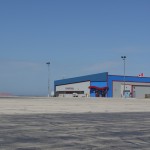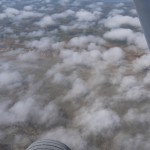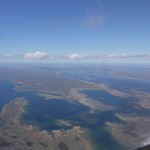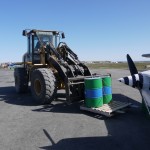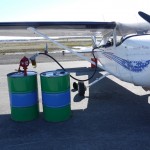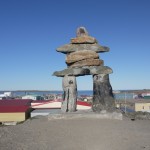The next morning started with a beautiful sky. My friendly hosts took me to a nice little breakfast place where I had to brush up all the terms for all those different kinds of eggs. I enjoyed my sunny-side-up egg and gained all the strength necessary for my next flight. It would be short 2 hour flight, so no flight plan was filed. I was thinking there would be enough traffic following available. Which of course, there was not.
My first take-off from a gravel runway was uneventful. I managed not to damage the airplane, and flew over Churchill city, waving my hosts goodbye. I crossed a little bit of water and followed the shoreline for almost the entire 2 hours. While flying, I was constantly hopping frequencies in an idle attempt to maintain radio contact if the need arised. I had been told this was prime polar bear season, so I was very eager to see these creatures in real life. They should be collecting at the shore, waiting for the big Hudson Bay to freeze over again, so I flew at 2000ft over the shore. My disappointment was enormous when I arrived at Rankin Inlet (CYRT) without seeing even one polar bear!
Rankin Inlet is used as one of the main hubs for the Arctic traffic. Rankin Inlet was also the first airport where I landed that was referenced to True North instead of Magnetic North. Yet another clue my destination came closer. Once landed in Rankin Inlet, I needed to look for the fuel company that was supposed to have a building nearby the airport. This was my last chance to buy some cheap avgas, so I was planning on buying 2 drums of 55 USG worth of Avgas. But first I had to find the company.
Rankin Inlet was a place of many firsts: first true north reference, first fuelling out of drums and also my first contact with the Canadian natives: the Inuït. A lot of these people use the airport as the only means of transportation to go visit friends and relatives. A lot of these people also work at the airport, often one of the only places where you could actually work in the arctic. One other unfortunate thing that defined them, was that they were often poorer than the other people that lived there. Which resulted in quite an old not so well maintained airport building. In a very friendly but often with an extremely strong accent, they explained me where I needed to be.
This was yet another moment I was always looking forward to: meeting the voice you’ve heard so many times before on the phone. The friendly Derek arranged my fuel. There was quite a long wait, which gave me a little more insight in the fuel economics of Rankin Inlet. There was one company selling all kinds of fuel (to burn, to drive, to use in ones snow scooter, for airplanes etc). The prices were determined by the government and –luckily for me- heavily subsidized. 45 minutes later, my fuel arrived at my plane. Some heavy machinery brought it right where it needed to be. When the two drums were standing in front of me, I realized how much 110 USG of fuel actually is. It’s a massive amount to put in a Cessna 172.
Now it was time to try and open the fuel drum. I’m very grateful that Dave, the mechanic from Muskoka, gave me a drum opener right before I left. I made sure I brought pumps, but I forgot about the first basic step. First I used my Leatherman knife to try and make an opening in the plastic cap. Two finger cuts later, I saw the metal seal underneath the cap. I squeezed the drum opener in, bruised another finger and with a wonderful hiss, the drum was ready to release all its fuel. I put the fuel pump in the drum, and attached to other end of the hose to the ferry tank. This was the easiest tank to start the fueling, since it was within reach. I started rotating the pump, when I saw the little sticker on the pump. It needed 100 rotations to transfer 5 USG… After an hour of fuel transfer, the first drum was finally empty. With a slightly increased skill, I managed to open up the other drum just a little bit faster. By now, the ferry tank was almost full, which made it very hard to put any extra fuel in it. The constant switching between venting the air from the tank, rotating the fuel pump and making sure the fuel hose was not cut off due to the position of the tank, mixed in with the occasional bump on the head on the wings, made it one of the more frustrating moments of the trip.
When the main ferry tank was filled, I started putting fuel in the wing tanks. This included moving a fuel drum that’s half full. Not an easy task to do by yourself. Half an hour later, the fuelling was finished. Originally, the plan was to put up my tent, and camp somewhere in the village. Given my bruised fingers, all the cuts, my hands that were showered in fuel and started to look weirdishly white, my clothes and gear that was all covered in the grey arctic dust, me being very tired and the not really friendly looking village, I treated myself by renting a room for 175 dollars. And yes, a room, that’s all it was. A room with a bed, and a shared bathroom.
All the gear was settled in, and it was time to visit the village. I visted the big Inukshuk (big pile of rocks, like a totem pole) in the middle of the city. Unfortunately vandalism is also quite a plague in this part of the world. So there were some custom paintjobs on the Inukshuk. Still, it managed to remain very majestuous.
While I walked around the town and the little coast line it was a shame there was soo much garbage lying around, especially at the rocky beach. In the town center you could see a lot of people were using the fuel drums of the company where I bought my fuel, but they all left them outside. It gave quite a view of the average fuel consumption of a family. The dented old barrels were more than a year old, the empty new ones with the paint still on probably quite recent.
I got back at the ‘hotel’ and called up Aziz, my contact in Resolute Bay. Everything was arranged for my stop the next day. If the weather was good, I would be inside the Arctic circle tomorrow. This put a smile on my face, and I went to bed.
- Churchill airport building
- Churchill from the sky
- Coast line below some low scattered clouds
- Beautiful view: the mix of land and water
- Bringing out the trucks
- Fuelling in progress
- Rankin Inlet big Inukshuk
